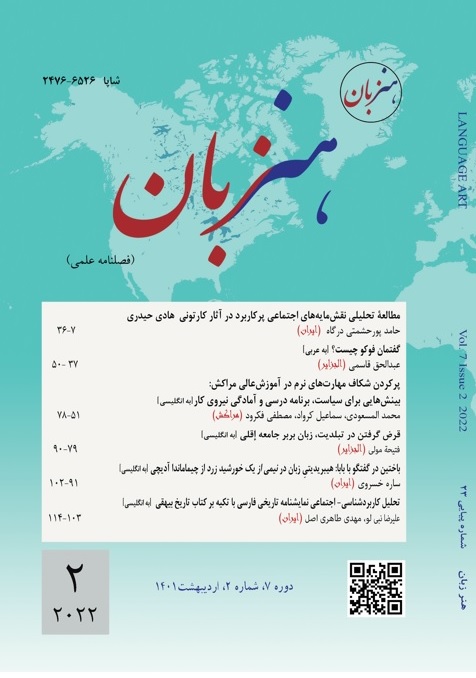Bakhtin in Dialogue with Bhabha: Hybridization of Language in Chimamanda Adichie’s Half of a Yellow Sun
DOI:
https://doi.org/10.22046/LA.2022.11الكلمات المفتاحية:
Bakhtin، Bhabha، Heteroglossia، Hybridization of Language، Mimicry، Mockeryالملخص
The present research paper, by combining Mikhail Bakhtin’s ideas on heteroglossia with Homi Bhabha’s hybridity, aims to examine the hybridization of language in Chimamanda Ngozi Adichie’s novel Half of a Yellow Sun. Hybridization is a process whereby separate entities create another entity which shares certain features with each of its sources but which is not purely compositional. Hybridization in language happens when two or more languages are frequently mixed. As a consequence, a new hybrid variety of languages emerged. The study claims that Half of a Yellow Sun, because of its diverse set of speech types and its characters who differ in terms of their race, class and gender, has a good potentiality to be discussed in matters related to hybridization of language, which is considered to be a kind of heteroglossia. The thing that the characters speak English does not mean that they are following the ideology of the British. Their English is imbued with Igbo words and phrases. Therefore, the hybrid nature of the English language used by the characters shows how the language is at the service of postcolonial identity formation. Based on Bhabha’s ideas on mimicry and mockery, the study concludes that the character’s mingling of English and Igbo language is a way of misrepresenting Standard English or, to use the Caliban paradigm, cursing the master’s tongue. As a result, the hybridization of language in Half of a Yellow Sun is an attempt on the part of Adichie to appropriate English language or to make it one’s own.
المراجع
Adichie, Chimamanda, Ngozi (2006). Half of a Yellow Sun. New York: Anchor.
Akpome Aghogho (2013). “Focalization and Polyvocality in Chimamanda Ngozi Adichie’s Half of a Yellow Sun”. English Studies in Africa, 56(2): 25-35.
Anidi, Ojel Clara. Kadiri, Goodluck Chinenye, Otagburuagu, Emeka Joseph (2015). “Multilingualism in Nigerian Literature: A Study of Chimamanda Ngozi Adichie’s Half of a Yellow Sun.” International Journal of Research in Humanities, Arts and Literature. 3(9): 27-36.
Azodo, Ada Uzoamaka (2008). Interview with Chimamanda Ngozi Adichie: Creative Writing and Literary Activism'. Indiana: University Northwest.
Bakhtin, Mikhail (1984). Problems of Dostoevsky's Poetics. Minnesota: University of Minnesota Press.
Bakhtin, Mikhail (1994). Dialogic Imagination. Austin: University of Texas Press.
Bhabha, Homi K. (1994). The Location of Culture. London: New York: Routledge.
Das, Bijay Kumar (2005). Twentieth Century Literary Criticism. Delhi: Atlantic
Dhobi, Saleem (2013). “Bhabha’s Concept of Hybridity in Chimamanda Ngozi Adichie’s Half of a Yellow Sun: A Postcolonial Critique” [Unpublished Master’s Thesis]. Tribhuvan University.
Gandhi, Leela (1998). Postcolonial Theory: A Critical Introduction. Sydney: Allen & Unwin.
Pinker, S. (2007). The Stuff of Thought: Language as a Window into Human Nature. London: Viking Penguin Group.
Ross, Michael L. (2019). “Ownership of Language: Diglossia in the Fiction of Chimamanda Ngozi Adichie”. Research in African Literature. 50(1): 111-126.
Sarfraz, Nida, Kousar, Rehana, Qasim, Khamsa (2016). “Reclamation of History: Discerning Polyvocal and Decentering Voices in Half of a Yellow Sun. Language in India. 17(2): 160-193.
Shakespeare, William (2004). The Tempest. Irvine: Saddleback Classics.
Stockhammer, Philip, Wolfgang. (2012). Conceptualizing Cultural Hybridization: A Transdisciplinary Approach. Heidelberg: Springer.
التنزيلات
منشور
كيفية الاقتباس
إصدار
القسم
الرخصة
الحقوق الفكرية (c) 2022 sareh khosravi

هذا العمل مرخص بموجب Creative Commons Attribution 4.0 International License.

